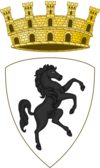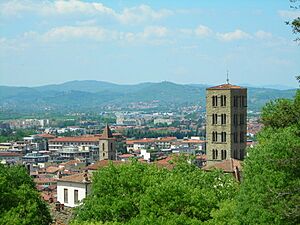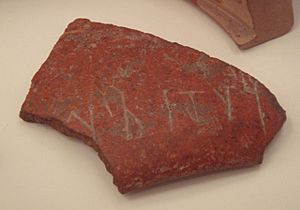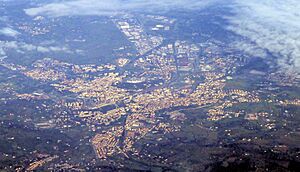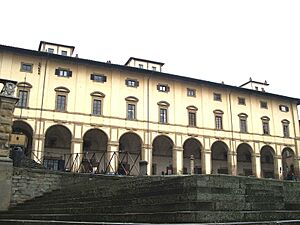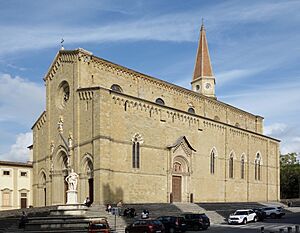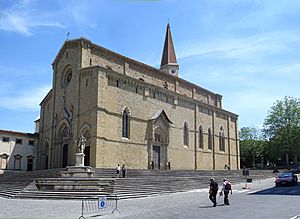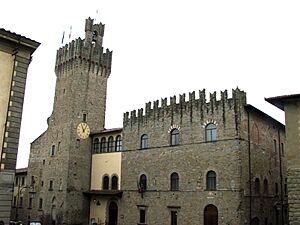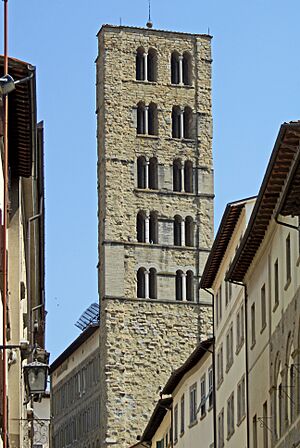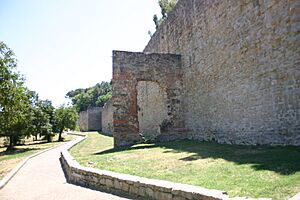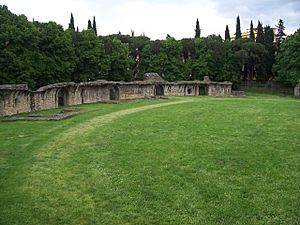Arezzo facts for kids
Quick facts for kids
Arezzo
|
|||
|---|---|---|---|
| Comune di Arezzo | |||
 |
|||
|
|||
| Country | Italy | ||
| Region | Tuscany | ||
| Province | Arezzo (AR) | ||
| Frazioni | see list | ||
| Area | |||
| • Total | 386.25 km2 (149.13 sq mi) | ||
| Elevation | 296 m (971 ft) | ||
| Population
(1 January 2020)
|
|||
| • Total | 100,734 | ||
| • Density | 260.800/km2 (675.469/sq mi) | ||
| Demonym(s) | Aretini | ||
| Time zone | UTC+1 (CET) | ||
| • Summer (DST) | UTC+2 (CEST) | ||
| Postal code |
52100
|
||
| Dialing code | 0575 | ||
| Patron saint | Saint Donatus of Arezzo | ||
| Saint day | 7 August | ||
Arezzo is a city and a comune (like a municipality) in Italy. It is the capital of the province of the same name, located in the beautiful region of Tuscany. Arezzo is about 80 kilometers (50 miles) southeast of Florence. It sits at an elevation of 296 meters (971 feet) above sea level. In 2022, about 97,000 people lived there.
Arezzo is famous for its gold and high fashion. Many famous artists and poets came from here. These include Giorgio Vasari, Guido of Arezzo, and Guittone d'Arezzo. The famous Renaissance artist Michelangelo was also from this province.
The city is well-known for the amazing frescoes by Piero della Francesca. You can see them inside the Basilica of San Francesco. There is also a beautiful crucifix by Cimabue in the Basilica of San Domenico. Arezzo is also famous for the exciting Giostra del Saracino. This is a medieval game of chivalry that dates back to the Middle Ages.
Contents
History of Arezzo
Arezzo has a very long and interesting history. Long ago, it was called Aritim by the Etruscans. They were an ancient people who lived in Italy before the Romans. The historian Livy called Arezzo one of the main Etruscan cities. It was likely one of the twelve most important Etruscan cities, part of the Etruscan League.
We know a lot about the Etruscan past of Arezzo. There are parts of old walls and an Etruscan cemetery. The most famous discoveries are two bronze statues. These are the "Chimera of Arezzo" (from the 5th century BC) and the "Minerva" (from the 4th century BC). Both were found in the 1500s and are now in Florence.
The Romans took over Arezzo in 311 BC. It became an important military stop on the via Cassia road. This road helped Rome expand into the Po River area. Arezzo was known for its pottery. They made special molded and glazed pots called Arretine ware. These pots were sent all over the Roman Empire.
In the 3rd and 4th centuries, Arezzo became a city with its own bishops. These bishops often acted like rulers of the city in the Middle Ages. The old Roman city was damaged during wars and by invaders like the Lombards. People then used the stones to build new defenses. Only the Roman amphitheater remained.
Arezzo became an independent city-state in 1098. This means it ruled itself, separate from the bishops. It was often against Florence, another powerful city. In 1252, Arezzo started its own university. After a big battle in 1289, Arezzo's power began to fade. It eventually came under the control of Florence in 1384.
During this time, Piero della Francesca worked in Arezzo. He created his famous frescoes in the church of San Francesco di Arezzo. These beautiful paintings are still one of Arezzo's most famous artworks. After this, the city became less important economically and culturally. This actually helped preserve its medieval center.
In the 18th century, the nearby marshes were drained. This made the area healthier. Later, Napoleon Bonaparte's French troops took over Arezzo. But the city fought back strongly. In 1860, Arezzo became part of the new Kingdom of Italy.
Arezzo was heavily damaged during World War II. German forces fought hard there in July 1944. British and New Zealand troops finally freed the town on July 16, 1944. There is a cemetery nearby, the Commonwealth War Graves Commission's Arezzo War Cemetery, where 1,266 soldiers are buried.
Geography and Climate
Arezzo is built on a steep hill. It rises up from the flat land near the River Arno. At the top of the hill, you'll find the cathedral, the town hall, and the Medici Fortress. From there, the main streets go down towards the lower parts of the city. The upper part of Arezzo still looks very medieval.
Arezzo is in an area where earthquakes can happen. However, the risk of very strong earthquakes is much lower here than in some nearby regions. Strong earthquakes are rare in the province.
Climate in Arezzo
Arezzo has a humid subtropical climate. This means it has hot and dry summers. The winters are usually mild and rainy. The average temperature for the year is about 13.54°C (56.4°F). August is the hottest month, with an average of 23.56°C (74.4°F). January is the coldest, averaging 4.66°C (40.4°F).
The city gets about 864 millimeters (34 inches) of rain each year. November is the wettest month, while July is the driest.
| Climate data for Arezzo, elevation: 248 m or 814 ft, 1991-2020 normals, extremes 1938–present | |||||||||||||
|---|---|---|---|---|---|---|---|---|---|---|---|---|---|
| Month | Jan | Feb | Mar | Apr | May | Jun | Jul | Aug | Sep | Oct | Nov | Dec | Year |
| Record high °C (°F) | 17.4 (63.3) |
22.0 (71.6) |
25.8 (78.4) |
30.2 (86.4) |
36.0 (96.8) |
38.9 (102.0) |
40.5 (104.9) |
40.4 (104.7) |
36.2 (97.2) |
30.0 (86.0) |
23.4 (74.1) |
18.0 (64.4) |
40.4 (104.7) |
| Mean daily maximum °C (°F) | 9.3 (48.7) |
11.0 (51.8) |
14.9 (58.8) |
18.8 (65.8) |
23.4 (74.1) |
28.0 (82.4) |
31.4 (88.5) |
31.7 (89.1) |
25.7 (78.3) |
19.9 (67.8) |
13.9 (57.0) |
9.8 (49.6) |
19.8 (67.6) |
| Daily mean °C (°F) | 4.7 (40.5) |
5.5 (41.9) |
8.8 (47.8) |
12.1 (53.8) |
16.6 (61.9) |
20.7 (69.3) |
23.6 (74.5) |
23.6 (74.5) |
18.5 (65.3) |
14.0 (57.2) |
9.2 (48.6) |
5.4 (41.7) |
13.5 (56.3) |
| Mean daily minimum °C (°F) | 0.3 (32.5) |
0.5 (32.9) |
2.9 (37.2) |
5.5 (41.9) |
9.5 (49.1) |
13.2 (55.8) |
15.4 (59.7) |
15.5 (59.9) |
11.8 (53.2) |
8.5 (47.3) |
4.8 (40.6) |
1.1 (34.0) |
7.4 (45.3) |
| Record low °C (°F) | −20.2 (−4.4) |
−20.0 (−4.0) |
−10.0 (14.0) |
−5.4 (22.3) |
−3.1 (26.4) |
0.8 (33.4) |
4.8 (40.6) |
5.8 (42.4) |
0.5 (32.9) |
−3.7 (25.3) |
−8.0 (17.6) |
−15.0 (5.0) |
−20.2 (−4.4) |
| Average precipitation mm (inches) | 52.8 (2.08) |
57.0 (2.24) |
63.5 (2.50) |
71.3 (2.81) |
74.5 (2.93) |
52.8 (2.08) |
42.2 (1.66) |
43.0 (1.69) |
96.0 (3.78) |
108.7 (4.28) |
120.8 (4.76) |
81.6 (3.21) |
864.0 (34.02) |
| Average precipitation days (≥ 1.0 mm) | 6.93 | 6.93 | 7.27 | 8.90 | 8.57 | 6.13 | 3.90 | 3.90 | 6.97 | 8.50 | 10.13 | 8.53 | 86.66 |
| Average relative humidity (%) | 76.4 | 70.4 | 67.2 | 66.9 | 67.2 | 65.3 | 62.0 | 61.5 | 66.6 | 73.4 | 78.3 | 77.6 | 69.4 |
| Average dew point °C (°F) | 1.0 (33.8) |
0.3 (32.5) |
2.4 (36.3) |
5.5 (41.9) |
9.7 (49.5) |
13.0 (55.4) |
14.1 (57.4) |
14.2 (57.6) |
11.8 (53.2) |
9.7 (49.5) |
6.1 (43.0) |
2.0 (35.6) |
7.5 (45.5) |
| Source 1: NOAA | |||||||||||||
| Source 2: Temperature estreme in Toscana | |||||||||||||
Hamlets
Arezzo is surrounded by many smaller towns and villages, which are called frazioni or hamlets.
Population
| Historical population | |||||||||||||||||||||||||||||||||||||||||||||||||||||||
|---|---|---|---|---|---|---|---|---|---|---|---|---|---|---|---|---|---|---|---|---|---|---|---|---|---|---|---|---|---|---|---|---|---|---|---|---|---|---|---|---|---|---|---|---|---|---|---|---|---|---|---|---|---|---|---|
|
|
||||||||||||||||||||||||||||||||||||||||||||||||||||||
| Source: ISTAT | |||||||||||||||||||||||||||||||||||||||||||||||||||||||
Culture and Festivals
Arezzo is a city rich in culture, especially known for its exciting festivals.
Festivals
- Guido d'Arezzo Polyphonic Contest: Every year, Arezzo hosts an international competition for choral singing. It's named after Guido of Arezzo, a famous music theorist.
- Saracen Joust (Giostra del Saracino): This is a popular medieval festival. "Knights" on horseback, representing different parts of the town, charge at a wooden target. They score points based on how accurately they hit it. Almost everyone in the town dresses up in medieval costumes and cheers for their team!
- PLAY Arezzo Art Festival: From 1986 to 2006, Arezzo had a big music and culture festival called Arezzo Wave. It was replaced in 2007 by PLAY Arezzo Art Festival. This festival still features rock music and includes local bands. Famous artists like Peter Gabriel and Lou Reed have performed here.
Main Sights to See

Piazza Grande
Piazza Grande is the most famous medieval square in Arezzo. It opens up behind the old Romanesque church of Santa Maria della Pieve. This square used to be the city's main market. Today, it is where the exciting Giostra del Saracino (Joust of the Saracen) takes place. The square has a unique sloped floor made of red bricks with limestone lines.
Other important buildings around the square include:
- The Palace of the Lay Fraternity: A beautiful palace from the 14th and 15th centuries.
- The Vasari Loggia: A long, flat building designed by the famous artist Giorgio Vasari.
- Episcopal Palace: This is where the bishops live. It was rebuilt in the mid-13th century. In front of it is a statue of Grand Duke Ferdinando I de' Medici.
Churches
Arezzo has many historic churches, each with its own unique beauty and history.
- Santa Maria della Pieve: This Romanesque church has a huge, square bell tower. It was built in the 12th century and later updated. Inside, you can see a beautiful painting by Pietro Lorenzetti.
- Cathedral of Saint Donatus: This Gothic-style church was built between the 13th and early 16th centuries. Its front was finished in the 20th century. Inside, there's a famous fresco by Piero della Francesca showing the Madeleine.
- Basilica of San Francesco: Built in the 13th–14th centuries, this church is famous for its The History of the True Cross frescoes. These amazing paintings by Piero della Francesca are in the Bacci Chapel.
- Basilica of San Domenico: Started in 1275, this church has a single main area. It holds a very important Crucifix by Cimabue, a masterpiece from the 13th century.
- Badia delle Sante Flora e Lucilla: This abbey was built by monks in the 12th century. It was completely restored in the 16th century by Giorgio Vasari. Inside, you can see an amazing painting by Andrea Pozzo that looks like a fake dome.
Other Sights
- Roman Amphitheater: You can explore the remains of an ancient Roman amphitheater and visit its museum.
- Palazzo dei Priori: Built in 1333, this building has been the city's government seat for centuries. It has a 16th-century courtyard and artworks by Giorgio Vasari.
- Medici Fortress (Fortezza Medicea): This fortress was designed by Antonio da Sangallo the Younger and finished in the mid-1500s.
- Casa Vasari: This is the house of the famous artist and architect Giorgio Vasari. He rebuilt and decorated it himself. Today, it's a museum where you can see his frescoes and learn about his life.
- Ivan Bruschi House and Museum: A museum showcasing art and antique collections.
- Gaio Cilnio Mecenate Archeological Museum: This museum displays artifacts from Arezzo's ancient past.
- Civic Museum of Modern and Contemporary Art: Here you can see artworks from more recent times.
- UnoAErre Jewelry Museum: Arezzo is known for its gold, and this museum celebrates its jewelry-making history.
Sports
Arezzo has several sports teams and clubs:
- Associazione Calcio Arezzo (A.C. Arezzo) is the city's football (soccer) team.
- Vasari Rugby Arezzo is the local rugby club.
- Club sommozzatori Calypso is a diving club.
Famous People from Arezzo
Many talented people have come from Arezzo or lived there:
- Margaritone d'Arezzo (around 1250–1290), a painter from the 13th century.
- Roberto Benigni (born 1952), a famous actor and director.
- Andrea Cesalpino (1524–1603), a physician, botanist, and philosopher.
- Guido d'Arezzo (around 991–992 – after 1033), a music theorist who helped invent modern music notation.
- Piero della Francesca (1412–1492), a painter who spent most of his life in Arezzo.
- Michelangelo (1475–1564), one of the most famous artists of all time, was born near Arezzo.
- Petrarch (1304–1374), a famous poet.
- Giorgio Vasari (1511–1574), a painter, architect, and writer.
Sister Cities
Arezzo is twinned with several cities around the world. This means they have special friendly relationships.
|
See also
 In Spanish: Arezzo para niños
In Spanish: Arezzo para niños



